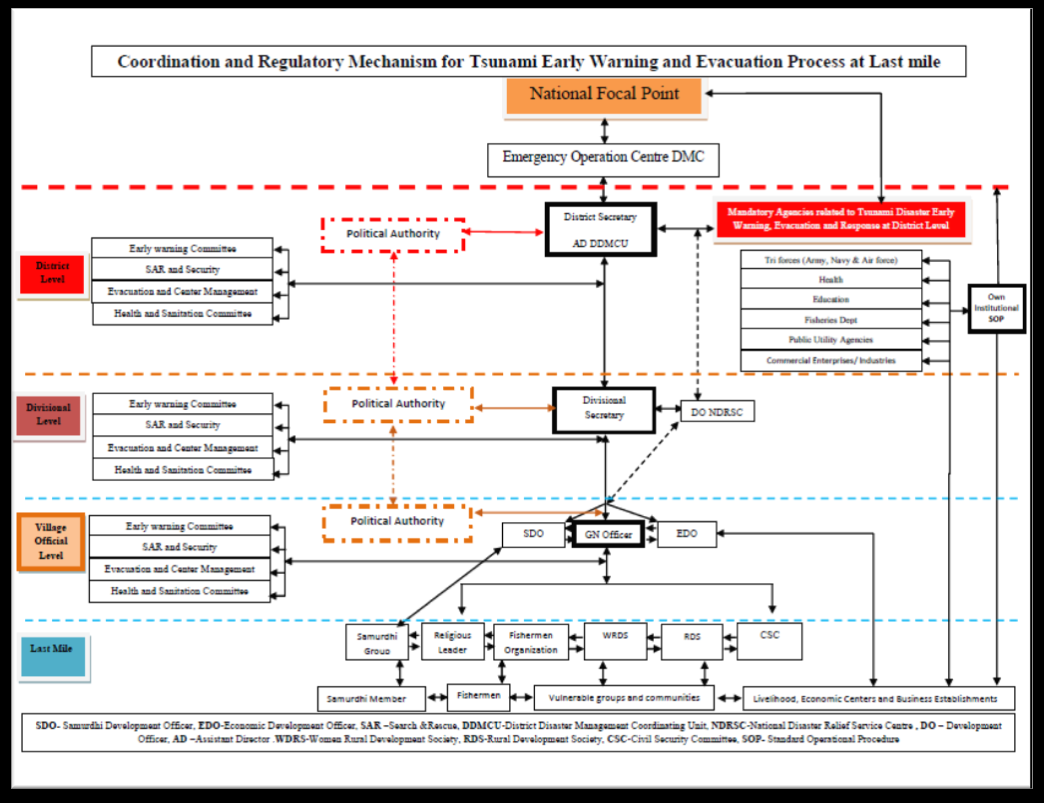Sri Lanka
Sri Lanka's National Tsunami Exercise (IOWave -20) Event - on the occasion of IDDRR and WTAD 2020
Organizer(s)
Disaster Management Center
Date
- Sri Lanka was one of the countries struck by tsunami due to the Indian Ocean earthquake on 26th December 2004, with many lives being lost and over half a million people being displaced. The World Tsunami Awareness Day is observed on 5th November annually and Sri Lanka has been commemorating this unfortunate devastation in all fourteen coastal districts across the country, followed by multi religious activities in remembrance of all those who lost their lives in 2004 tsunami. Accordingly, in line with the International Day for Disaster Risk Reduction (IDDR) we are conducting the National Tsunami Exercise (IOWave-20) exercise based on Indian Ocean Tsunami Warning and Mitigation System (IOTWMS) with the help of three (3) technical agencies or Tsunami Service Providers (TSPs) namely Bureau of Meteorology – Australia, Indian National Centre for Ocean Information Services (INCOIS) and Badan Meteorologi Klimatologi dan Geofisika (BMKG) Indonesia. With the formulation of the IOTWMS framework, 28 countries bordering the Indian Ocean will participate in this year’s scheduled IOWave-20 exercise. As a member state Sri Lanka is participating for this exercise on 13th October 2020 and the Disaster Management Centre (DMC) has selected four (4) districts amidst the sudden re-emergence of Covid-19 pandemic in the country, once again. Accordingly, arrangements have been made to conduct the Table Top Exercise (TTX) in these districts by selecting the most vulnerable divisional secretaries in the coastal region.
- The planned comprehensive TTX was carried out at national level on 7th October2020 with the participation of all relevant stakeholders, along with district management units and relevant authorities, including local representatives.
- On 13th October 2020, the Disaster Management Centre (DMC) will test the early warning dissemination system and communication protocols (refer annexure 1), by practicing the Standard Operating Procedures (SOPs) of each stakeholder agency. In this context we are practicing the district level evacuation by way of Table Top Exercise (TTX) disseminating early warning messages through the military and police unit of the DMC, to relevant vulnerable groups.
- The Evacuation Planning process developed to face a calamity such as Tsunami is as follows.
- Prepare for planning - Mandates; planning team and resources persons; data and information; resources; planning process time frame
- Understand community’s Tsunami risk - Hazard; exposure of people and facilities, capabilities
- Design evacuation strategy and map - Evacuation time, zone (s), safe areas, assembly areas, modes of evacuation, evacuation shelter buildings, evacuation routes, signage, went (self) evacuate; support (traffic control, vulnerable facilities)
- Access, endorse and disseminate evacuation plan - Public assessment of the plan, endorsement by local authorities, dissemination to institutions and public, outreach strategy
- Test, evaluate and improve evacuation plan – Tsunami simulation exercises, means of observation and evaluation, revision of evacuation plan
- As per the developed District Level Evacuation Plan, necessary arrangements will be made to evacuate the below mentioned key segments in the populace.
- Military, Police and government institutions
- Industries and factories
- Harbours and airports (if any)
- Schools
- Hospitals
- Urban neighbourhoods
- Hotels
- Villages
- Possible indicators of Tsunami readiness at community level are as follows:
- Guaranteed and reliable means of receiving and disseminating 24/7 official Tsunami alerts
- Tsunami hazard zone maps at community level
- Information of the lay of the land and geography
- Information of the number of people living in the hazard areas
- Information of all installations, establishments, public and private infrastructure etc. and capacity
- Information of institutional evacuation plans
- Information of all safety centres and ensuring individual awareness of the centre dedication
- Awareness of personal Tsunami bio data card for the registration at centres
- Public display of Tsunami information
- Inventory of resources to reduce Tsunami risk at the community level
- Simple and comprehensive Tsunami evacuation plans and maps for the assimilation of local authorities and community members
- Awareness and public education systems and rehearsals
- Annual Tsunami Evacuation community exercise
- Tsunami emergency operation SOP and plan
- Capacity to manage emergency response operations
- Upon completion of the scheduled simulation exercise, the nominated evaluators will need to address the drawbacks based on the evaluators’ reports and make innovative and practical recommendations for further improvement.

Hazards
Is this page useful?
Yes No Report an issue on this pageThank you. If you have 2 minutes, we would benefit from additional feedback (link opens in a new window).
